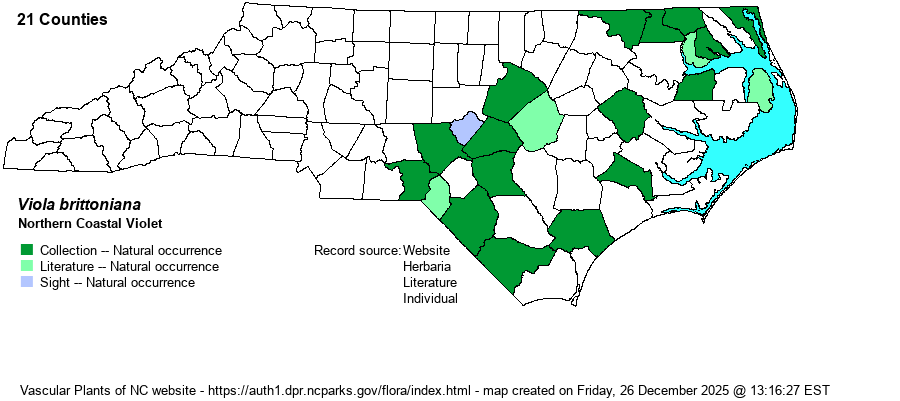| Author | Pollard | |
| Distribution | Only in the Coastal Plain, including the Sandhills region; scattered nearly throughout the province, though oddly no records for the many counties surrounding Pamlico Sound.
This is a violet with an odd range for the genus, limited to the Coastal Plain and somewhat Northern, as well. It ranges from eastern MA south to SC, ranging west barely to eastern PA.
| |
| Abundance | Uncommon and local, to locally very rare. Though RAB (1968) states "locally abundant", this might not be the case today. This is a Watch List species. | |
| Habitat | This is a wetland species, growing in seepages, openings in swamps, at the edges of brackish to fresh marshes, and damp pinewoods. It generally grows in acidic soil. | |
| Phenology | Blooms in April and May, and fruits shortly after flowering. | |
| Identification | This is a robust and fairly tall acaulescent violet, with the naked flowering stalks often reaching to 8-9 inches tall. The leaves are deeply cleft, typically into 7-11 linear segments, with the middle one often wider; the blade is about 2 inches across, wider and longer than in most other violets. The flower is a rich violet to purple with a white center and is quite large, usually about 1.5 inches tall and wide. Thus, in bloom this is a very stunning species, and the highly dissected leaves, a bit like those of the often seen V. pedata, make it hard to overlook. V. pectinata, however, has somewhat triangular leaves and may cause confusion with this species; however, the basal portion of these leaves has large and sharp teeth, not deep clefts or lobes. V. pedata, a species of dry roadbanks or other dry sites, has similar narrow segments as with the frequent form, but that species has the orange stamens extending past the throat (as opposed to hidden inside the throat), and has the lateral petals glabrous inside the throat as opposed to bearded in V. brittoniana. | |
| Taxonomic Comments | Weakley et al. (2024) splits out V. brittoniana into two full species -- this and V. pectinata. Most older references have these as varieties, and so the present one is usually named as V. brittoniana var. brittoniana.
General note on Viola: In 2009-10 B.A. Sorrie (website map editor) went through the whole collection at NCU, annotating all specimens against those verified by experts in the genus. The range maps in RAB (1968) have been changed accordingly. More recently, Harvey Ballard and colleagues are in the process of revising all Eastern and Southeastern Viola, and have annotated all specimens at NCU in July 2024. They recognize additional species not in RAB or in previous editions of Weakley et al.; we will follow updated editions of Weakley et al. in recognizing them. Species range maps have been adjusted to account for identification changes. | |
| Other Common Name(s) | Coast Violet, Britton's Violet | |
| State Rank | S2? [S2S3] | |
| Global Rank | G3? | |
| State Status | W7 [W1] | |
| US Status | | |
| USACE-agcp | FAC link |
| USACE-emp | FAC link |

